
6288
.pdf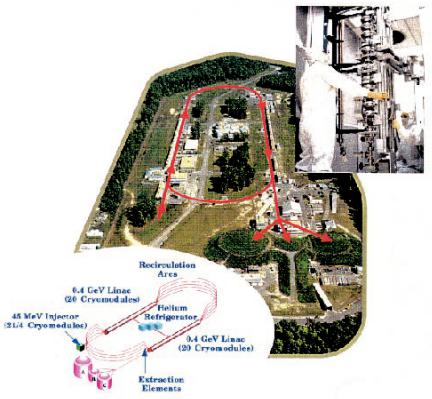
Nuclear Physics: The Core of Matter, The Fuel of Stars
http://www.nap.edu/catalog/6288.html
154 |
NUCLEAR PHYSICS: THE CORE OF MATTER, THE FUEL OF STARS |
FIGURE 7.1 Schematic and aerial view of CEBAF at the Thomas Jefferson National Accelerator Facility (TJNAF) in Newport News, Virginia. The accelerator is based on superconducting cavities for acceleration. Beams are recirculated and accelerated up to 5 times to provide intense continuous electron beams of 1-5 GeV, polarized and unpolarized, to three target areas simultaneously. The photo insert shows assembly of a superconducting cavity section in the clean room. (Courtesy TJNAF.)
Accelerator Center (SLAC), and continue to be involved in measurements at Fermilab and other high-energy facilities around the world.
Two current key objectives of nuclear physics, understanding the quark structure of nucleons and nuclei and the search for the quark-gluon plasma, have demanded higher energies, beam currents, and duty factors for electrons, and much higher energies for heavy ions. This motivated the construction of two large facilities designed specifically for nuclear physics at these research frontiers: CEBAF at the Thomas Jefferson National Accelerator Facility (TJNAF) in Virginia (shown in Figure 7.1), a high-current, continuous-beam electron accelerator of moderately high energy that has recently become operational; and the
Copyright © National Academy of Sciences. All rights reserved.
Nuclear Physics: The Core of Matter, The Fuel of Stars
http://www.nap.edu/catalog/6288.html
THE TOOLS OF NUCLEAR PHYSICS |
155 |
Relativistic Heavy Ion Collider (RHIC), the first high-energy heavy-ion collider, now nearing completion at Brookhaven National Laboratory (BNL).
Accelerator Research and Development
Most of the accelerator facilities in nuclear physics have developed in close association with the science on the one hand and with the more general research and development in accelerator science and technology on the other. Long-term accelerator R&D has led to new technologies and new science in nuclear physics, with significant spin-off into other areas of science.
Superconducting magnet development at Michigan State University has led to compact, powerful cyclotrons for heavy-ion beams; superconducting beam bending and focusing magnets for the highest-energy beams, originally developed for proton accelerators in particle physics, have been extended for use with heavy-ion beams at RHIC.
Superconducting radio-frequency (rf) cavities have been successfully developed over the past two decades for acceleration of low-velocity heavy ions and of high-velocity electrons. Cavities for heavy ions, first developed and implemented at Argonne National Laboratory in the early 1970s and soon after at the State University of New York at Stony Brook and other universities, provide cost-effective and versatile postaccelerators for high-quality ion beams that cover the full mass range from protons to uranium. The successful operating experience with this new technology bolstered its development and application to the higher velocities required in the accelerators for particle physics. In nuclear physics, recent R&D at TJNAF led to the development of reliable, high-gradient, superconducting acceleration cavities with higher-order mode suppression for electrons at the velocity of light. R&D in this area could lead to a further factor of two or so in gradient and will likely open this technology to other applications, such as the use of superconducting rf cavities as accelerator drivers for highpower interaction regions and ultraviolet free-electron lasers and, possibly, in high-energy linear colliders.
The development of high-charge-state electron cyclotron resonance (ECR) ion sources is revolutionizing the acceleration of heavy-ion beams both at cyclotrons and at heavy-ion linacs. Since energy gains increase with ionic charge state, acceleration of highly charged ions makes the most efficient use of accelerator voltages.
The development of polarized beams and targets has made major strides. Developments in atomic-beam techniques at the University of Wisconsin are providing polarized gas targets and polarized ion sources, and long-lived frozen polarized targets have been developed at various facilities. Laser polarized targets have been developed for hydrogen, helium, and lithium ions at various universities and national laboratories. So-called Siberian snakes and spin rotators
Copyright © National Academy of Sciences. All rights reserved.

Nuclear Physics: The Core of Matter, The Fuel of Stars
http://www.nap.edu/catalog/6288.html
156 |
NUCLEAR PHYSICS: THE CORE OF MATTER, THE FUEL OF STARS |
FIGURE 7.2 Schematics of the two principal concepts for the generation of energetic beams of shortlived nuclei (radioactive beams). The top figure illustrates the in-flight projectile fragmentation approach in which an energetic particle (typically several tens of MeV/u to GeV/u) is fragmented in a nuclear reaction in a thin target, and radioactive reaction products are separated in flight and transported as a secondary beam to the experiment. The ISOL (isotope separator online) approach illustrated at the bottom employs two independent accelerators: a high-power driver accelerator for production of the short-lived nuclei in a thick target that is directly connected to an ion-source and a postaccelerator. Radioactive atoms diffuse out of the hot target into the ion source where they are ionized for acceleration in the postaccelerator. This scheme provides for excellent beam quality since it allows full control over beam energy and time structure.
Copyright © National Academy of Sciences. All rights reserved.
Nuclear Physics: The Core of Matter, The Fuel of Stars
http://www.nap.edu/catalog/6288.html
THE TOOLS OF NUCLEAR PHYSICS |
157 |
based on a superconducting helical dipole magnet design are allowing acceleration and complex manipulations of polarized beams.
Electron cooling of ion beams in storage rings has greatly advanced, allowing precision in-beam nuclear physics measurements in storage rings with internal targets. The low emittance of the cooled, stored proton beam at the Indiana University Cyclotron Facility (IUCF) has proved to be an excellent tool to study threshold reactions for nuclear physics on the one hand and nonlinear, singleparticle beam dynamics effects of interest to accelerator physicists on the other.
Some of the developments mentioned have occurred at the larger user facilities. But often smaller facilities, in particular those at universities, have provided the environment for generic developments that have important applications to the research programs at large accelerators. This exemplifies the symbiotic relationship between small university accelerators and large national and international facilities in nuclear physics.
Several new projects are in progress or under consideration. First, there is the completion of RHIC, expected for 1999, with ongoing R&D efforts to extend its performance beyond the design parameters: superconducting magnet control, bunched-beam stochastic cooling, and the implementation of polarized protonbeam operation. A viable, bunched-beam, stochastic cooling system could potentially ameliorate the effects of intrabeam scattering in heavy-ion beams and thus significantly improve performance. A recent decision to implement polarized proton operation at RHIC has led to an R&D program to develop the previously mentioned Siberian snakes and spin rotators.
The 1996 NSAC Long Range Plan recommended an upgrade, now under way, of the radioactive-beam capabilities at Michigan State University. Two superconducting cyclotrons are being upgraded to boost the energy and intensity of the primary production beam at this radioactive-beam facility of the in-flight fragmentation type. Radioactive-beam intensities will be increased by factors ranging from 100 to 1,000. Figure 7.2 shows the schematics of the two principal approaches to radioactive-beam facilities—in-flight fragmentation and the twoaccelerator ISOL (isotope separator online) concept.
The NSAC Long-Range Plan also recommends development of a next-gen- eration, ISOL-type, radioactive-beam facility based on the two-accelerator (driver/post-accelerator) concept, with its construction to begin once construction of RHIC is substantially completed. The advanced ISOL facility will bring together the fruits of a number of current accelerator developments—suitable radiofrequency quadrupole accelerators, high-power conventional and superconducting linacs or cyclotrons, and the developments of target/ion source systems— that have been carried out in recent years at a variety of nuclear physics facilities.
A list of present accelerators for nuclear physics research in the United States is given in Appendix A with a short summary of their respective performance characteristics.
Copyright © National Academy of Sciences. All rights reserved.
Nuclear Physics: The Core of Matter, The Fuel of Stars
http://www.nap.edu/catalog/6288.html
158 |
NUCLEAR PHYSICS: THE CORE OF MATTER, THE FUEL OF STARS |
INSTRUMENTATION
Major progress made in target and detector systems in recent years underlies many of the current advances in nuclear science. Polarized targets of light nuclei, produced either by atomic-beam techniques or by novel approaches using laserinduced polarization, have played an important role in fixed-target experiments, as well as in experiments using internal targets in storage rings. Advances in particle detectors range from single detectors at low energies to complex detector arrays for the highest energies and the largest particle multiplicities. Most detectors are used in experiments with beams from accelerators, but stand-alone systems also play an important role and have undergone major developments. It is not possible to give a detailed discussion of all the recent developments within the limited space available in this report. Rather, we will give selected examples from the various areas of nuclear physics research to provide a taste of the novel developments and genuine advances that these targets and detectors represent for the science.
Examples of New Detector Systems
Ion and Atom Traps
At the lowest energies, novel structure information on nuclei has been obtained by trapping nuclei, in particular short-lived, radioactive ones far from stability, in ion or atom traps and by measuring their masses and the properties of their radioactive decays.
Trapping atoms in magneto-optical traps with the help of lasers has made major advances over the last decade (as shown in Figure 7.3). This technique promises unique advances in studying nuclear decays, allowing precision studies of fundamental symmetries under controlled conditions. For example, atomic experiments can measure parity-violating matrix elements with significant precision. The heaviest alkali, francium, promises particularly large sensitivity to parity violations because of its simple structure, with only one electron outside of a spherical core. Francium has no stable isotopes, making it difficult to carry out this important class of measurements. However, several laboratories have recently taken an important step in starting these measurements, by efficiently collecting the small number of francium atoms created in a nuclear reaction and cooling them sufficiently to confine them in a laser trap. To reach the intensities of trapped ions needed for the symmetry studies, major advances are needed in production yield and trapping. The next-generation ISOL facility will provide the required intensities.
The use of ion traps in nuclear physics has proven equally exciting. Penning traps have been effective instruments for high-accuracy mass determinations. With these devices, the mass ratios of a number of stable or long-lived light
Copyright © National Academy of Sciences. All rights reserved.
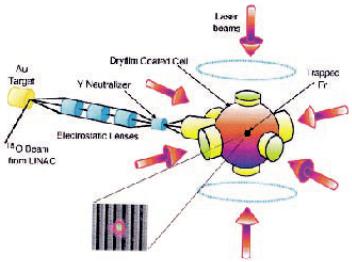
Nuclear Physics: The Core of Matter, The Fuel of Stars
http://www.nap.edu/catalog/6288.html
THE TOOLS OF NUCLEAR PHYSICS |
159 |
FIGURE 7.3 Schematic layout of a magneto-optical trap, which uses a combination of a weak magnetic field and six intersecting polarized laser beams to capture radioactive atoms generated in a nuclear reaction. These atoms are captured by neutralization and thermalization of a low-energy radioactive ion beam. Once captured in the trap, these atoms can become an ideal source for precision studies of nuclear decays that address aspects of fundamental symmetries and the Standard Model.
particles have been determined to high accuracy, on the order of a part in a hundred million. High-accuracy measurements with radionuclides have been performed for an accurate determination of the binding energies of nuclei.
Exploring the Structure of Exotic Nuclei
Novel high-precision mass measurements have also been made in a storage ring. Signals have been detected from as little as a single circulating ion of a specific isotope.
Advanced detectors for nuclear reactions near the Coulomb barrier allow one to explore the behavior of the nucleus under the extremes of excitation, spin, and neutron-to-proton ratio. High-sensitivity recoil systems allow identification of the rarest reaction products in heavy-ion fusion reactions at zero degrees, which are usually hidden in an overwhelming background from the incident particle beam. This has allowed nuclear physics, for example, to identify the new heavy elements up to 112, and a number of proton emitters, literally dripping protons, at the proton drip line.
New information about high-spin states in nuclei has been obtained with large, highly efficient germanium detector arrays. The Gammasphere array con-
Copyright © National Academy of Sciences. All rights reserved.
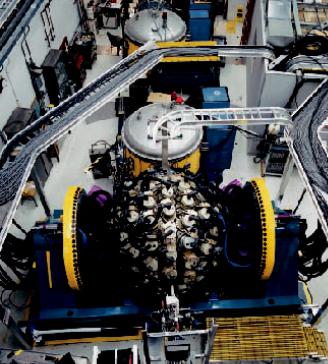
Nuclear Physics: The Core of Matter, The Fuel of Stars
http://www.nap.edu/catalog/6288.html
160 |
NUCLEAR PHYSICS: THE CORE OF MATTER, THE FUEL OF STARS |
sists of 100 large Compton-suppressed germanium crystals. Using its high efficiency for high-energy gamma rays, it has been possible to identify, unambiguously, the transitions linking states in the superdeformed and normally deformed potential minima. The combination of such powerful high-resolution detectors with the highly selective recoil systems shown in Figure 7.4, supports studies of nuclear structure out to the limits of nuclear existence. Similarly, new highresolution magnetic spectrometers allow precision nuclear structure studies in reactions with radioactive beams or polarized light-ion beams. Figure 7.5 shows the recently completed superconducting magnetic spectrograph at Michigan State University for a broad range of studies with radioactive beams.
FIGURE 7.4 Gammasphere, the national gamma-ray facility for studies in nuclear structure research, mounted in front of the fragment mass analyzer (FMA) at the ATLAS accelerator at Argonne National Laboratory (ANL). Gammasphere was built at the Lawrence Berkeley National Laboratory in a collaboration of national laboratories and universities and is the premier detector for nuclear structure research with gamma rays. The FMA is an electromagnetic ion-beam filter that allows researchers to select rare nuclear reaction products out of an overwhelming background of beam particles at zero degrees, and then study their decay through coincidence with the cascade of decay gamma rays detected by Gammasphere. (Courtesy ANL.)
Copyright © National Academy of Sciences. All rights reserved.
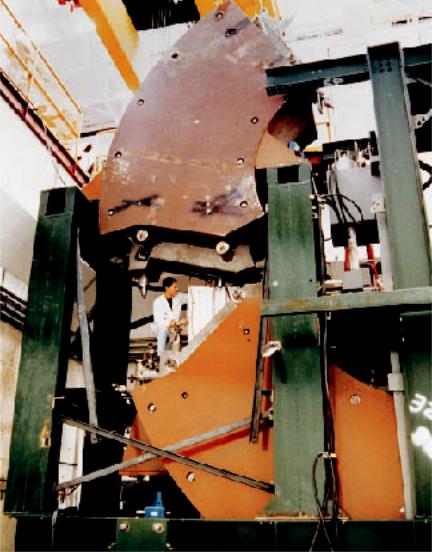
Nuclear Physics: The Core of Matter, The Fuel of Stars
http://www.nap.edu/catalog/6288.html
THE TOOLS OF NUCLEAR PHYSICS |
161 |
FIGURE 7.5 The superconducting magnetic spectrograph S800 at Michigan State University. The target for the nuclear reactions is at the bottom left of the spectrometer structure. Reaction products from nuclear collisions, induced by beams of shortlived nuclei (radioactive beams) are selected and bent upwards by powerful superconducting magnets onto the focal-plane detector system mounted on the top of the spectrograph. (Courtesy MSU.)
Copyright © National Academy of Sciences. All rights reserved.
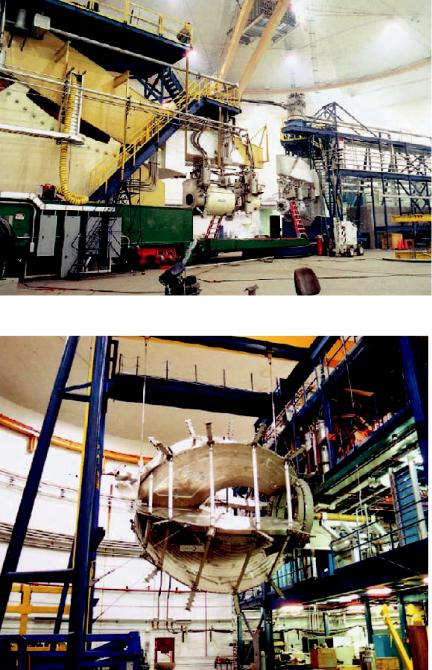
Nuclear Physics: The Core of Matter, The Fuel of Stars
http://www.nap.edu/catalog/6288.html
162 |
NUCLEAR PHYSICS: THE CORE OF MATTER, THE FUEL OF STARS |
Hall A
Hall B
Copyright © National Academy of Sciences. All rights reserved.
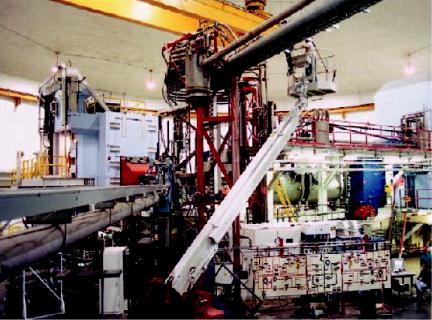
Nuclear Physics: The Core of Matter, The Fuel of Stars
http://www.nap.edu/catalog/6288.html
THE TOOLS OF NUCLEAR PHYSICS |
163 |
Hall C
FIGURE 7.6 The three experimental halls at CEBAF at the Thomas Jefferson National Accelerator Facility in Newport News, Virginia. Hall A houses two high-resolution magnetic spectrometers based on superconducting magnetic dipoles to bend the reaction products into their focal-plane detector systems. Hall B houses a clam-shell-type, largeacceptance, magnetic spectrometer, again based on superconducting magnets, but with a novel technology that uses iron-free magnet coils. Hall C houses a combination of a highresolution magnetic spectrometer for electrons and a short-orbit spectrometer to allow detection of short-lived particles before they decay. (Courtesy TJNAF.)
Detectors for the Quark Structure of Matter
The program to elucidate the quark and gluon substructure of nucleons and nuclei requires large, high-quality spectrometers at high energies and momenta. At TJNAF, two of the three experimental areas house pairs of large magnetic spectrometers (shown in Figure 7.6). The spectrometers are equipped with sophisticated focal-plane detection systems with high rate capabilities, to detect, identify, and analyze with excellent resolution electrons as well as hadronic reaction products, i.e., mesons, nucleons, and hyperons. A third hall houses a novel large-acceptance spectrometer, with its magnetic field generated by a sixcoil, iron-free, superconducting toroidal magnet and a complex particle detector array. At MIT’s Bates accelerator, a novel detector, the Bates Large Acceptance
Copyright © National Academy of Sciences. All rights reserved.
